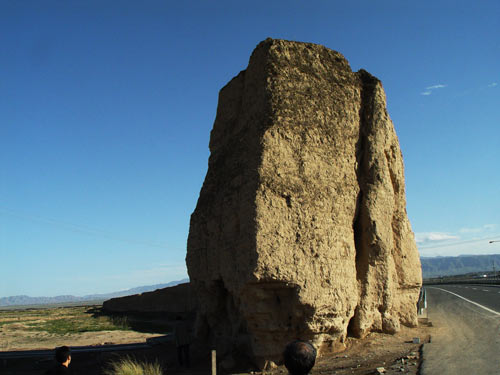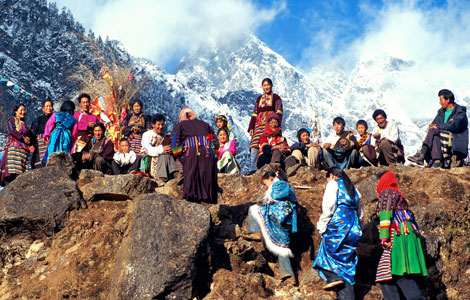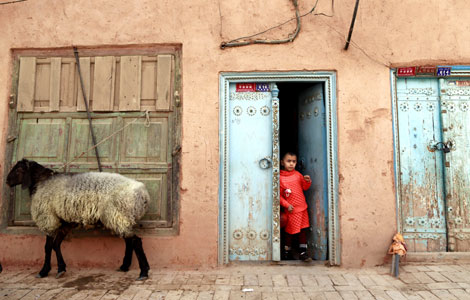Palette of life
Updated: 2013-11-07 00:53
By Li Yang (China Daily)
|
|||||||||
 |
|
The sections of the Great Walls built in the Han and Ming dynasties is one of two major attractions in Zhangye, Gansu province. Qi Ta / For China Daily |
Zhangye has a rich historical legacy. North of the city, thousands of ancient tombs are covered by potato fields or stretches of sand. Thousands more have already been robbed or destroyed.
It is said one 50-km section of road in Zhangye connecting Gansu and the Xinjiang Uygur autonomous region was built with the remains of ancient tombs, which were looted by the local warlord Ma Bufang to pay for his soldiers' provisions during China's civil war between 1945 and 1949.
Dafo Temple in Zhangye's urban area is famous for a clay sleeping Sakyamuni sculpture 35 meters long and 8 meters wide.
The temple, built in the Western Xia regime (1038-1277), gradually became the largest Buddhist center in the Hexi Corridor after several rounds of rebuilding. Kublai Khan, grandson of Genghis Khan and emperor of the Yuan Dynasty (1271-1368), was said to be born in the temple in 1215.
The exchange of civilizations on the Silk Road brought a treasure trove of ancient Buddhist books to the temple, most of which were destroyed during the "cultural revolution" (1966-76), including those hidden in the abdomen of the big Buddha statue.
The valuable Buddhist texts exhibited in the temple today, dating back to the Tang Dynasty (AD 618-907), were protected in the scripture library by a nun named Benjue. She secretly hid 12 boxes of valuable books in her tiny room in 1955 until her death in a fire in 1975.
To the south of Zhangye, out of the Danxia range, lies the Shandan army-horse-breeding farm of 2,200 square km. It's one of the largest of its kind in the world. The farm was built in the Han Dynasty to defend against the invading nomadic tribes and prospered until the late Qing Dynasty (1644-1911). It is now operated by a State-owned enterprise of animal husbandry for agricultural production and tourism.
North of Zhangye, two parallel Great Walls built with soil run 10 to 80 meters apart for almost 100 km at the foot of the Qilian Mountains along the Hexi Corridor. They represent one of the best-preserved Great Wall sections in China.
The outer wall was built in 111 BC in the Han Dynasty, while the inner wall was built in 1572 in the Ming Dynasty. They look magnificent against the bigger backdrop of the snow-capped Qilian Mountains.
The local government protects the walls with barbed wire to prevent shepherds from digging dwelling caves in the wall or farmers from digging into the wall for soil.
To the south are dozens of ancient city ruins deserted by armies and residents since the Han Dynasty because of water shortages. Strong weathering leaves rings of earthen city walls covered with sand — a treasure trove for explorers.
Xue Chaohua contributed to this story.

 Post-baby Duchess
Post-baby Duchess
 Victoria Beckham S/S 2014 presented during NYFW
Victoria Beckham S/S 2014 presented during NYFW
 'Despicable' minions upset Depp's 'Lone Ranger' at box office
'Despicable' minions upset Depp's 'Lone Ranger' at box office
 'Taken 2' grabs movie box office crown
'Taken 2' grabs movie box office crown
 Rihanna's 'Diamonds' tops UK pop chart
Rihanna's 'Diamonds' tops UK pop chart
 Fans get look at vintage Rolling Stones
Fans get look at vintage Rolling Stones
 Celebrities attend Power of Women event
Celebrities attend Power of Women event
 Ang Lee breaks 'every rule' to make unlikely new Life of Pi film
Ang Lee breaks 'every rule' to make unlikely new Life of Pi film
Most Viewed
Editor's Picks

|

|

|

|

|

|
Today's Top News
Startup contest is a win-win for all
Incubators discussed in LA
Thousands rally over Kimmel show remark
Emitters join in carbon reductions
SOE reforms to be launched
'Singles Day' to see big spenders
Launch zone challenges
CPC session begins to set reform agenda
US Weekly

|

|







